
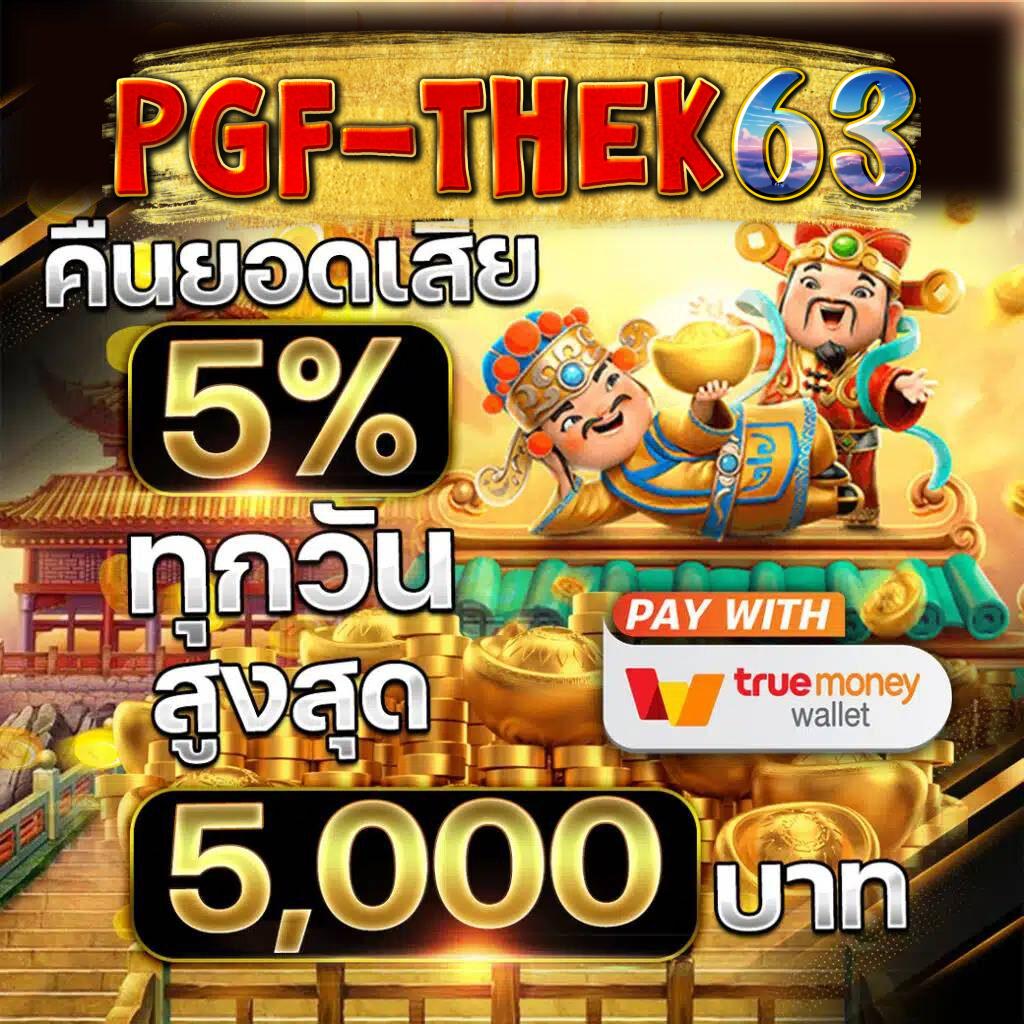
pgf-thek63 slot สล็อต บาคาร่า เครดิตฟรี แจกทุกยูส อันดับ 1
pgf-thek63 ให้บริการเดิมพันเล่นเกมพนันออนไลน์ครบวงจร ไม่ว่าคุณจะชอบเกมการเดิมพันที่มาในรูปแบบใด เว็บไซต์ของเราจัดได้ว่าพัฒนาและรวบรวมเข้ามาไว้ในเว็บเดียว จัดได้ว่าสมัคร pgf-thek63 เพียงแค่เว็บไซต์เดียวเท่านั้น ก็สามารถที่จะทำให้คุณได้เล่นเกมพนันออนไลน์ครบทุกรูปแบบและเว็บไซต์ thek63 ของเรานั้นยังได้มีการพัฒนาให้สามารถที่จะรองรับได้กับทุกระบบปฏิบัติการ ไม่ว่าจะเป็นระบบ iOS หรือจะเป็นระบบแอนดรอยด์ ก็สามารถรองรับการใช้งานได้เป็นอย่างดี
และมีความเสถียร อีกทั้งเรานั้นยังมาพร้อมกับการรองรับการใช้งานได้ทุกอุปกรณ์ ไม่ว่าจะเป็นคอมพิวเตอร์ iPad แท็บเลท หรือจะเป็นอุปกรณ์อิเล็กทรอนิกส์ต่างๆ เว็บไซต์ Thek63 slot ของเราก็สามารถที่จะรองรับกับการใช้งานได้อย่างมีประสิทธิภาพ และสามารถเดิมพันได้แบบไม่มีขั้นต่ำ จัดได้ว่าเว็บไซต์ pgf-thek63 ของเรานี้ให้บริการผู้เล่นทุนน้อยได้เป็นอย่างดี พร้อมการันตีเงินรางวัลเพียบ
pgf-thek63 คืออะไร ? ทำไมเป็นที่นิยม เว็บตรง แหล่งรวมเกมยอดฮิต แตกง่าย รางวัลสูง โบนัส แจ็คพอตเพียบ

pgf-thek63 เป็นช่องทางที่ดีที่สุดในการเดิมพัน เล่นเกมพนันออนไลน์ ก่อนอื่นต้องแนะนำเลยว่า ในปัจจุบันนี้เกมพนันออนไลน์ได้รับความนิยมมากมาย ซึ่งไม่ว่าจะเป็นทั้งไทยและต่างประเทศ ล้วนแล้วแต่นิยมกันอย่างแพร่หลาย เพราะสามารถเดิมพันง่ายและที่นี่เว็บตรง thek63 ยังใช้เงินทุนในการเดิมพันต่ำ และที่สำคัญสามารถเดิมพันได้ตลอด 24 ชั่วโมง และเกมสล็อตนั้นยังสามารถรู้ผลการออกรางวัลได้เลยทันที ผู้เล่นไม่ต้องรอรู้ผลการออกรางวัลให้เสียเวลา
ซึ่งจัดได้ว่าเพียงกดสปินที่นี่ pgf-thek63 ก็ได้รับรางวัลเลยทันที ซึ่งเกมสล็อตออนไลน์ผ่านช่องทางเว็บไซต์ตรงของเรา Thek63 slot มีเงินรางวัลมากมาย ไม่ว่าจะเป็นโบนัสหรือแจ็คพอต ยังรวมไปถึงเงินรางวัลอื่นๆอีกมากมาย ดังนั้นจะรอช้าทำไม เพียงแค่คุณอยากเปลี่ยนเศษเงินในบัญชีให้กลายเป็นเงินรางวัลก้อนโต ก็สามารถทำได้ง่ายๆ เพียงเปิดยูสเซอร์เข้าเดิมพันกับเรา pgf-thek63 ที่นี่ก็มีสิทธิ์รับรางวัลได้เลยทันทีตลอด 24 ชั่วโมง
เว็บตรง thek63 จัดหนัก สมัครรับโปรโมชั่น แจกโบนัสเครดิตฟรี 100%
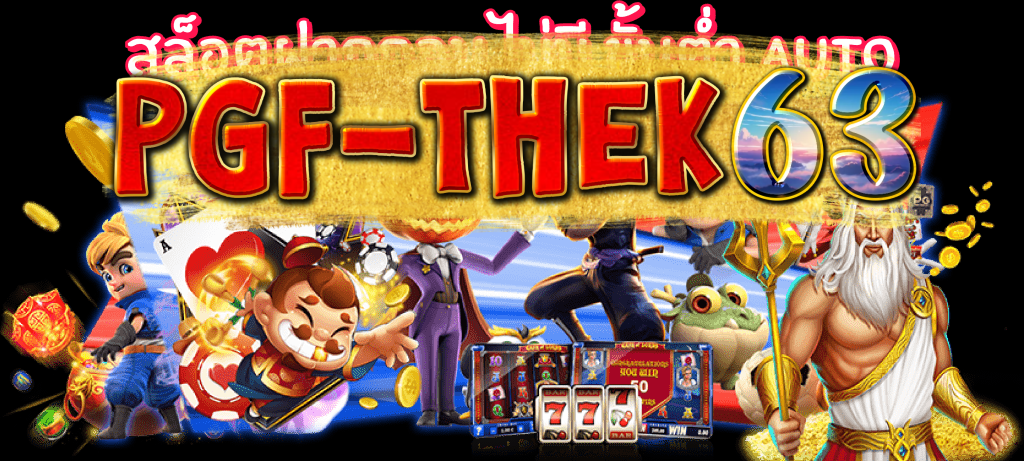
เว็บตรงเอาใจสายปั่น เอาใจนักเดิมพันมือใหม่ ะเพียงแค่คุณเปิดใจ เปิดยูสเซอร์ใหม่ เข้าเดิมพันกับเราที่นี่ pgf-thek63 สามารถรับโปรโมชั่นเครดิตฟรีไปได้เลยทันทีสูงสุด 100% ยิ่งหากคุณฝากครั้งแรกเข้าเดิมพันกับเราในอัตราที่สูงเท่าไหร่ ก็รับความคุ้มค่ากลับไปมากเท่านั้น จัดได้ว่าฝาก 100 รับทันที 100 บาท สามารถนำไปเป็นทุนในการเดิมพันเล่นเกมต่างๆ บนเว็บไซต์ Thek63 slot ของเราได้เลยทันที ซึ่งเว็บไซต์ thek63 ของเรานี้มีเกมให้เลือกเดิมพันกันมากมายและหลากหลายค่ายชั้นนำ ไม่ว่าคุณต้องการอยากจะเดิมพันกับเกมไหน ค่ายใด สามารถนำเครดิตฟรีที่ได้ไปเป็นทุนเดิมพัน และยังสามารถถอนกำไรกลับได้ไม่อั้น ไม่มีขั้นต่ำ ไม่มีติดเทิร์น
3 เหตุผลที่ควรเลือก เดิมพันที่นี่ Thek63 slot เว็บตรง ไม่ผ่านเอเย่นต์ เล่นได้ 24 ชั่วโมง รองรับระบบออโต้
ด้วย 3 เหตุผลหลักที่เลือกเดิมพันปั่นสล็อตออนไลน์ ผ่านช่องทางเว็บไซต์นี้ Thek63 slot เพราะเป็นเว็บตรงลิขสิทธิ์แท้มาแรงของต่างประเทศ มาพร้อมกับใบเซอร์การันตีรับรอง ได้รับอนุญาตให้เปิดอย่างถูกต้อง และยังมีหน้าเว็บไซต์หลักที่ชัดเจน ผู้เล่นที่มีความสนใจไม่ต้องดาวน์โหลดแอพพลิเคชั่นและไม่ต้องติดตั้งเ พราะเพียงแค่คุณกดลิงค์แนะนำหรือกดเข้าไปได้เลยที่นี่
หน้าเว็บไซต์ thek63 ทำการสมัครสมาชิกได้เลยทันที อีกทั้งที่นี่ยังมาพร้อมกับการรองรับการใช้งานด้วยระบบอัตโนมัติ ซึ่งจัดได้ว่าให้ความสะดวกสบายเป็นอย่างมาก และทุกฟังก์ชันบนเว็บไซต์ของเรา pgf-thek63 ยังสามารถทำให้ผู้เล่นกำหนดการใช้งานได้ด้วยตัวเอง และเปิดให้บริการตลอด 24 ชั่วโมง ไม่ปิดระบบ ไม่ปิดเว็บไซต์ ต้องการเดิมพันเมื่อไหร่ ล็อกอินเข้าสู่ระบบเดิมพันได้เลยทันที
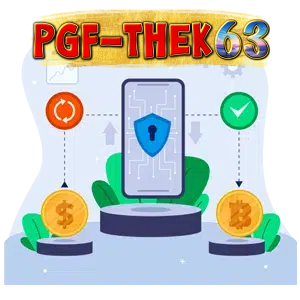
1. สมัครง่าย ไม่ต้องดาวน์โหลดแอพพลิเคชั่น
ด้วยเว็บไซต์นี้เป็น เว็บไซต์ตรง จึงได้รับการพัฒนาเว็บไซต์อย่างต่อเนื่อง ดังนั้นสำหรับใครที่ต้องการสมัครสมาชิก เข้าเดิมพัน สามารถคลิกลิ้งค์แนะนำหรือหน้าเว็บไซต์ได้เลยทันที ไม่ต้องดาวน์โหลดแอพพลิเคชั่น ไม่ต้องติดตั้ง เพราะเรานั้นมีหน้าเว็บไซต์หลักที่ชัดเจน

2. ทุกฟังก์ชั่น รองรับการใช้งานระบบอัตโนมัติ
เว็บไซต์ตรง รองรับทุกความต้องการของนักเดิมพัน พนันออนไลน์ สำหรับเว็บไซต์ของเรานั้น ซึ่งเป็นเว็บไซต์ตรงลิขสิทธิ์แท้ จึงได้มีการพัฒนาให้สามารถที่จะรองรับกับการใช้งานทุกฟังก์ชั่นด้วย ระบบอัตโนมัติ เพื่อความสะดวก สบาย ปลอดภัยในการใช้งาน ไม่ว่าจะเป็นวิธีการสมัครสมาชิก หรือแม้แต่วิธีการฝากถอนเงิน ทุกฟังก์ชันล้วนแล้วแต่รองรับระบบอัตโนมัติทั้งสิ้น

3. เปิดบริการเดิมพันตลอด 24 ชั่วโมง
เว็บตรง เอาใจนักเดิมพัน ไม่ว่าคุณนั้นจะสะดวกเข้าเดิมพันกับเราเมื่อไหร่ ก็สามารถที่จะล็อกอินเข้าสู่ระบบ พร้อมกับวาง เดิมพัน ได้เลยทันที ซึ่งเราเปิดให้เล่นผ่านเว็บไซต์ของเรานี้ตลอด 24 ชั่วโมง ไม่ปิดระบบ ไม่ปิดเว็บไซต์ ไม่ว่าคุณจะสะดวกเวลาไหน ต้องการทำกำไรเมื่อไหร่ ก็สามารถที่จะเดิมพันได้เลยทันที เว็บตรงบริการดี มั่นคง ปลอดภัย เชื่อถือได้ 100%
รวมเกมใหม่มาแรง เว็บตรง pgf-thek63 เปิด 6 ค่ายดัง ทำเงินไว ใช้ทุนต่ำ ปั่นแตกง่าย รางวัลสูง
สล็อตเว็บตรง thek63 เปิดตัว 6 ค่ายดังทำเงินไว ใช้ทุนต่ำ ปั่นแตกง่าย รางวัลสูง ซึ่งเว็บไซต์ของเรานั้นเป็นเว็บตรง จึงได้มีการคัดสรรเฉพาะค่ายเกมดัง ยอดฮิต ยอดนิยม กระแสดังมาแรงแห่งปี 2024 เข้ามาไว้ที่นี่ทีเดียวเว็บตรง Thek63 slot จัดได้ว่าสมัครเพียงแค่เว็บไซต์เดียว ผู้เล่นสามารถที่จะเลือกเล่นค่ายเกมดังได้ครบทุกค่าย
และยังสามารถเดิมพันได้อย่างต่อเนื่อง ไม่ต้องโยกเงิน ไม่ต้องย้ายกระเป๋า จึงจัดได้ว่าการเลือกเว็บไซต์มีความสำคัญเป็นอย่างมาก หากคุณเลือกเดิมพันกับเว็บไซต์ pgf-thek63 การันตีคุณจะได้รับเงินรางวัลก้อนโต ไม่ว่าจะเป็นโบนัสหรือแจ็คพอต ยังรวมไปถึงการเข้าวินต่างๆได้ในเวลาอันรวดเร็ว และไม่ว่าคุณจะเดิมพันแตกรางวัลเท่าไหร่ ก็ยังสามารถถอนได้ไม่อั้น ไม่มีขั้นต่ำและไม่มีติดเทิร์น
CQ9

สำหรับค่ายนี้เป็น ค่ายชั้นนำ ยอดฮิต กระแสดังมาแรงแห่งปี 2024 ใครๆก็เลือกเล่นค่ายนี้ เพราะสามารถ เดิมพัน ได้ไม่มีขั้นต่ำและได้มีการพัฒนาเกมที่มาในรูปแบบใหม่ๆอยู่อย่างต่อเนื่องและสม่ำเสมอ
อีกทั้งยังสามารถรองรับการใช้งานด้วย ระบบอัตโนมัติ ไม่ว่าจะเป็นการกดสปิน เพียงแค่ผู้เล่นตั้งอัตราการเดิมพัน ตั้งค่ารอบปั่น กดสปินออโต้ได้เลยทันที
ดังนั้นจะเห็นได้เลยว่า ค่ายเกม นี้ได้มีการพัฒนาอยู่อย่างตลอดเวลาและสม่ำเสมอ ด้วยทีมงานที่เป็นระดับมืออาชีพ อีกทั้งยังได้พัฒนาตัวเกมใหม่ๆให้ผู้เล่นได้เล่นก่อนใครอย่างแน่นอน
ask me bet

ค่ายนี้ ค่ายใหญ่ พัฒนาเกมมากมายไม่ว่าผู้เล่นจะชอบเกม การเดิมพัน รูปแบบใด ชอบความตื่นเต้นเร้าใจแบบไหน ค่ายของเราก็ได้นำเข้ามาให้คุณได้เลือกเล่นครบทุกรูปแบบ
ไม่ว่าคุณนั้นจะชอบการเดิมพันสายบู๊ สายมันส์ หรือจะเป็น เกม แนวแอ็คชั่นแฟนตาซี ยังรวมไปถึงเกมสาวสวยสุดเซ็กซี่ เว็บไซต์ของเราก็มีให้คุณได้เลือกเล่นแบบจุใจครบทุกรูปแบบ
อีกทั้งเรานั้นยังมาพร้อมกับการแตกรางวัลมากมาย ไม่ว่า จะเป็น โบนัส หรือ แจ็คพอต ยังรวมไปถึงเงินรางวัลการเข้าวินต่างๆอีกมากมาย จัดได้ว่าค่ายนี้รวมเกมรางวัลสูง เข้ามาให้ผู้เล่นได้เลือกเล่นจุใจอย่างแน่นอน
AMB POKER

สำหรับ ค่ายเกม นี้ตอบโจทย์ทุกความต้องการนักพนันออนไลน์ไม่ว่าคุณนั้นจะชอบเกมการเดิมพัน พนันออนไลน์ รูปแบบใด เพียงแค่คุณเลือกเดิมพันกับเราที่นี่
สามารถรองรับได้กับทุกความต้องการอย่างแน่นอน เพราะที่นี่มีครบทุกรูปแบบไม่ว่าจะเป็น เกมไพ่ บาคาร่า หรือจะเป็นเกมแนวกีฬาอย่างเช่น บอล หรือมวย เราคัดสรรเฉพาะเกมน้ำดี เข้ามาให้คุณได้เลือกเล่นแบบจุใจ
และที่นี่ยังมาพร้อมกับความโดดเด่นอย่างเช่น เกมสล็อตออนไลน์ ที่พัฒนารูปแบบให้มีความ ทันสมัยใช้งานง่ายทุกฟังก์ชั่นรองรับออโต้และยังเปิดให้ เดิมพัน กันตลอด 24 ชั่วโมงอีกด้วย
BLUEPRINT GAMING

สำหรับ ค่ายเกม นี้ไม่มีใครที่จะไม่รู้จัก เพราะกำลังได้รับความนิยม โด่งดังที่สุดในปัจจุบันนี้ เพราะค่ายนี้มาพร้อมกับการแสดงค่าความผันผวนของเกมไว้บนหน้าเว็บไซต์
เพื่อให้ผู้เล่นนำมาเปรียบเทียบก่อนที่จะเลือก เกมเดิมพัน เพื่อที่จะให้ได้รับ รางวัลสูง ที่สุดเพราะเกมสล็อตนั้นจะมีรูปแบบการแตกรางวัลที่แตกต่างกันออกไป และแต่ละเกม
จะมีการคูณเงินรางวัลให้กับผู้เล่นได้รับไม่เท่ากัน ดังนั้นค่ายของเราจึงได้มีการแสดงค่า RTP และค่าความผันผวนของเกม ไว้ให้ผู้เล่นได้นำมาเปรียบเทียบก่อนจะ เดิมพัน เพื่อให้เข้าถึงเงินรางวัลได้อย่างรวดเร็ว
JILI Slot

เล่นเกมไหนไม่สนุก เล่นเกมไหนไม่ได้ กำไร ขอแนะนำค่ายของเรา เพราะถูกคัดสรรเกมดัง เกมดี ยอดฮิต รางวัลสูง เข้ามาให้ผู้เล่นได้เลือกเล่นแบบจุใจสำหรับค่ายเกมของเรานี้
มีเกมให้คุณได้เลือกเล่นมากกว่า 1000 เกม ซึ่งแต่ละเกมมีสีสันแตกต่างกันออกไป ไม่ว่าจะเป็นภาพ เสียง เอฟเฟค ล้วนแล้วแต่สุดตระการตา และยังมาพร้อมกับเงินรางวัลอีกมากมาย
จัดได้ว่าปั่นแตกง่าย ใช้ทุนต่ำ รางวัลสูง ต้องยกให้ค่ายเกมของเราที่ได้รับการการันตี จากผู้เล่นทั้งหลาย ไม่ว่าจะเป็นมืออาชีพหรือมือใหม่สามารถ ทำกำไร กลับไปได้เพียงตั้งแต่ครั้งแรกที่เดิมพัน
Pragmatic Play

ค่ายใหญ่ชั้นนำ ให้ทุกการเดิมพันมีความสนุกสนานพร้อมกับเงินรางวัลมากมาย สำหรับ ค่ายเกม ของเราไม่เพียงแค่พัฒนาตัวเกมให้มีความทันสมัย แต่ยังเพิ่มความสนุกสนานเร้าใจไปกับเงิน รางวัลโบนัส แจ็คพอตและรางวัลอื่นๆอีกมากมาย
จัดได้ว่า เดิมพัน ค่ายของเราเพียงค่ายเดียว สามารถที่จะทำให้คุณเปลี่ยนเศษเงินในบัญชี ให้กลายเป็นเงินรางวัลก้อนโตได้เพียงแค่ไม่กี่นาที
เพราะค่ายของเรานี้คัดสรรเฉพาะเกมดี เกมดัง รางวัลสูง เข้ามาให้สมาชิกของเราได้เลือกใช้งาน ซึ่งมีเกมมากกว่า 1000 เกม แต่ละเกมบอกเลยว่าสนุกสนานอย่างแน่นอน
เว็บใหญ่ pgf-thek63 ชี้เป้า 6 เกมดัง รางวัลสูง เดิมพันไม่มีขั้นต่ำ แตกง่ายไม่ล็อคยูส
สล็อตเว็บตรง thek63 แนะนำ 6 เกมดัง ทำเงินไว จัดได้ว่าเป็นเกมที่มีเงินรางวัลสูง มีโบนัสแจ็คพอตและยังมาพร้อมกับการใช้งานที่สะดวกสบาย เพราะทุกเกมที่เราคัดสรรมานั้นล้วนแล้วแต่รองรับการใช้งานที่เป็นระบบออโต้ และยังสามารถที่จะรองรับการใช้งานภาษาไทย ดังนั้นเพียงแค่คุณเลือกเกมเดิมพันที่เรา Thek63 slot แนะนำก็จะสามารถทำให้คุณมีสิทธิ์และมีโอกาสเข้าถึงเงินรางวัลได้อย่างรวดเร็วแน่นอน เพราะทุกเกมที่เราเว็บใหญ่ pgf-thek63 คัดสรรนำมาให้สมาชิกของเราได้ใช้งานนั้น เป็นเกมที่เล่นง่าย แตกรางวัลไว ไม่ล็อคยูสซอร์
3 SECRET CITIES
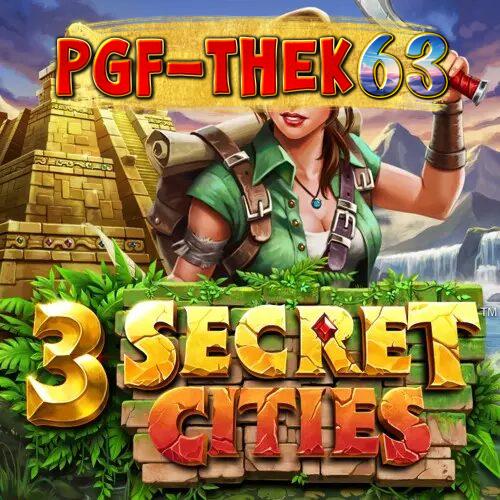
สำหรับ การเดิมพัน เกมนี้ เพียงแค่คุณกดสปินชนะรางวัลโบนัสได้อย่างรวดเร็ว เพราะเกมนี้มี RTPสูงถึง 96.50% และยังมาพร้อมกับฟีเจอร์ การซื้อฟรีสปินอัตรา แตกรางวัลสูง ถึง 98% และมาพร้อมกับเงินรางวัลสูงถึง 50000X ของเงินทุนเดิมพันกันเลยทีเดียว
และรูปแบบของการแตกรางวัลมีมากถึง 1024 วิธี ซึ่งจัดได้ว่าเป็นเกมที่มีเงินรางวัลสูงและมีรูปแบบของการแตกรางวัลที่หลากหลาย เป็นการเพิ่มโอกาสให้ผู้เล่นเข้าถึงเงินรางวัลได้อย่างรวดเร็ว
และยังมาพร้อมกับการลุ้นปั่นฟรีสปินมากกว่า 5 ถึง 10 รอบ กันเลยทีเดียว ดังนั้นแล้วสำหรับใครที่กำลังมองหา เกมเล่นสนุก รางวัลสูง แนะนำเลยเกมนี้ตอบโจทย์อย่างแน่นอน
HELIOS FURY
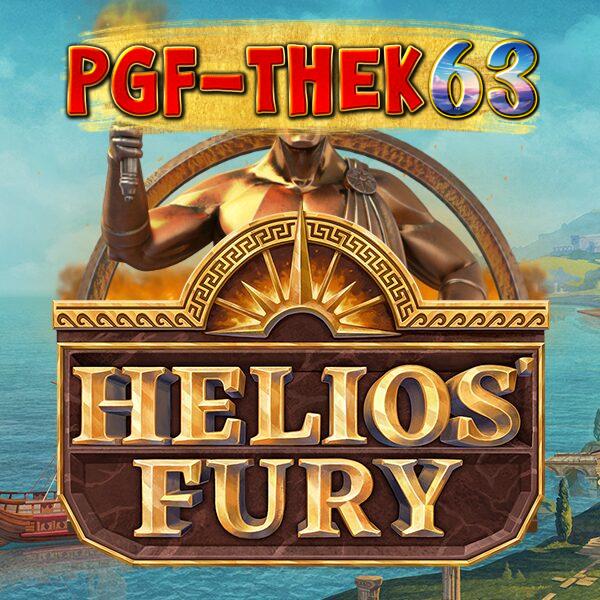
เกมดีเล่นง่าย ใช้ทุนต่ำ สำหรับเกมนี้สามารถวางเดิมพันได้แบบไม่มีขั้นต่ำ จึงตอบโจทย์ตอบสนองกับ นักเดิมพัน ทุนน้อยเป็นอย่างมาก และเพียงแค่คุณกดสปินมีสิทธิ์ลุ้นการเข้าวินแบบต่อเนื่อง เพราะเกมนี้มีการแตกรางวัลแบบต่อเนื่อง
ยิ่งหาก แตกรางวัล ต่อเนื่องนานเท่าไหร่ ก็จะได้รับรางวัลมากเท่านั้น และยังมาพร้อมกับการลุ้นปั่นแบบฟรีสปินมากกว่า 6 รอบ โดยมีสัญลักษณ์ไวล์ด ซึ่งเริ่มต้นอยู่ที่ตรงกลางของวงล้อที่หนึ่ง
และจะขยายพื้นที่ของรางวัลเพิ่มวงล้อเพิ่มขึ้นอีกเรื่อยๆ ดังนั้นแล้วจึงทำให้ผู้เล่นมีโอกาสเข้าถึงเงินรางวัลได้อย่างแน่นอนซึ่ง เกม นี้มีอัตรารางวัลมากกว่า 50000X เท่าของเงินทุนเดิมพัน จัดได้ว่าเป็น เกมดัง เกมฮิต รางวัลสูง
SANTA'S STACK

สำหรับเกมนี้ เหมาะสำหรับ นักเดิมพัน สายหวานสุดน่ารักซานตา ที่นำรางวัลมามอบให้นักเดิมพันแบบจัดหนัก จัดเต็ม เพียงกดสปินมีโอกาสได้รับ รางวัลโบนัส มากมาย โดยเฉพาะอย่างยิ่งมีการแจกฟรีสปินแบบต่อเนื่อง
เพราะเพียงแค่คุณเข้าโบนัสสเก็ตตอร์รับการหมุนฟรีเลยทันทีมากกว่า 10 รอบ และที่นี่ยังมาพร้อมกับอัตราการ แตกรางวัลสูง ถึง 96.2% ซึ่งเป็นการจ่ายรางวัลให้กับผู้เล่นได้รับสูง
ยังมาพร้อมกับฟังก์ชันที่เป็นภาษาไทย และรองรับการใช้งานระบบอัตโนมัติ เพียงแค่ผู้เล่นตั้งอัตรา การเดิมพัน ตั้งค่ารอบปั่น สามารถกดสปินออโต้ได้เลยทันที เพียงเท่านั้นก็รอ รับกำไร ได้แบบรัวๆ
DEEP DESCENT
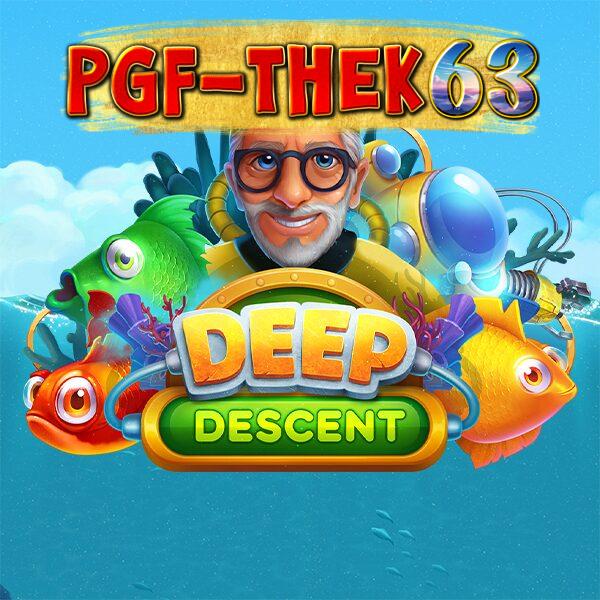
เข้ามาสนุกสุดมันส์ ไปกับ การแตกรางวัล แบบต่อเนื่อง สำหรับเกมนี้บอกเลยว่า มีการให้ค่าตอบแทนรางวัลกับผู้เล่นสูงถึง 10000X ของเงินทุนเดิมพันและสำหรับ เกม นี้มีรูปแบบของการแตกรางวัลมากกว่า 3125 รูปแบบ
ซึ่งจัดได้ว่ามีรูปแบบการแตกรางวัลมาก ดังนั้นผู้เล่นจึงมีโอกาสเข้าถึงเงินรางวัลได้อย่างรวดเร็วแน่นอน และเกมนี้ยังมาพร้อมกับเปอร์เซ็นต์การ แตกรางวัลสูง ถึง 95.00%
ซึ่งจัดได้ว่ามีเปอร์เซ็นต์การแตกรางวัลที่สูง อีกทั้งยังสามารถทำให้ผู้เล่นได้ลุ้นปั่นแบบฟรีสปิน เพียงแค่คุณสะสมเลเวลของตัวเกมให้ครบ ก็สามารถที่จะได้เข้าไป ลุ้นรางวัลก้อนโต ได้แบบง่ายๆในเวลาอันรวดเร็ว
STICKY BEES

สำหรับ เกม นี้มาพร้อมกับดนตรีสุดเร้าใจ และเพียงแค่คุณกดสปิน ก็มีสิทธิ์ลุ้นการเข้าวินได้แบบรวดเร็ว เพียงแค่คุณได้รับสัญลักษณ์วิน ซึ่งสามารถที่จะแทนที่ได้ทุกสัญลักษณ์ยกเว้น โบนัส เพราะสัญลักษณ์โบนัสนั้น
จะนำพาผู้เล่นเข้าไปสู่การปั้นแบบ ฟรีสปิน สูงถึง 7 รอบและในขณะที่เดิมพันด้วยฟรีสปินนั้น ผู้เล่นยังสามารถที่จะได้รับฟรีสปินเพิ่มมากขึ้นเรื่อยๆ โดยไม่มีกำหนดและเกมนี้ต้องบอกเลยว่า
มี เงินรางวัล มากกว่า 10000X ของเงินทุนเดิมพัน ยิ่งหากคุณวางเดิมพันมากเท่าไหร่ ก็จะได้รับรางวัลมากเท่านั้น และสำหรับใครที่ไม่ต้องการรอ เข้าโบนัส สามารถซื้อฟรีสปินได้เลยทันที เพียงเท่านี้ก็เข้ามาลุ้นรางวัลก้อนโตได้เลย
WILD WEST GOLD

รูปแบบการ ออกรางวัล สัญลักษณ์บนกระดาน จะออกรางวัลจากซ้ายไปขวาและสำหรับ เกม นี้ยังมาพร้อมกับสัญลักษณ์วิน ที่สามารถแทนที่ได้ทุกตัวยกเว้นสัญลักษณ์สเก็ตตอร์ และเพียงแค่สัญลักษณ์วินปรากฏในรีลที่ 2,3,4 เพียงเท่านั้น
ก็สามารถที่จะได้รับรางวัลคูณมากกว่า X5 และเพียงแค่คุณเดิมพันได้ รับรางวัล สเก็ตตอร์ เพียงแค่สามตัวเท่านั้นสามารถที่จะปั่นแบบ ฟรีสปิน มากกว่า 8 รอบ
และหากระหว่างที่คุณปั่นฟรีสปินอยู่นั้น ได้รับสัญลักษณ์ที่เป็นรูปโอเวอร์เลย์ สามารถรับฟรีสปินเพิ่มได้สูงสุด 20 รอบและสำหรับเกมนี้ มาพร้อมกับเงินรางวัลสูงถึง 10000X ของเงิน ทุนเดิมพัน และยังมีรูปแบบการแตกรางวัลมากกว่า40รูปแบบ
3 เทคนิคเดินเงิน ทำกำไรเว็บตรง pgf-thek63 ด้วยทุนต่ำ ทำกำไรสูง ในเวลาอันรวดเร็ว
สล็อตเว็บตรง thek63 แนะนำ 3 เทคนิคทำกำไรด้วยทุนต่ำก่อนอื่นต้องขอแนะนำเลยว่าในปัจจุบันนี้ เกมพนันออนไลน์ได้รับความนิยมมากมายและแพร่หลาย ไม่ว่าจะเป็นทั้งไทยและต่างประเทศ เพราะสามารถเดิมพันง่าย เดิมพันได้ไม่มีขั้นต่ำ โดยเฉพาะอย่างยิ่งเว็บไซต์ตรง Thek63 slot เว็บไซต์นี้สามารถเดิมพันได้ทุกที่ ทุกเวลา
เพราะสามารถที่จะรองรับได้กับทุกอุปกรณ์ในการเดิมพัน ไม่ว่าจะเป็นอุปกรณ์ใดหรือระบบปฎิบัติการใด ก็สามารถที่จะรองรับเว็บไซต์ของเราได้เป็นอย่างดี จัดได้ว่าเพียงแค่คุณเลือกเดิมพันกับเว็บไซต์ pgf-thek63 นี้ก็มีโอกาสชนะรางวัลสูง เพราะเรามาพร้อมกับเทคนิคการวางเดิมพันแบบง่ายๆด้วยทุนต่ำ สามารถนำไปเป็นแนวทางได้เลยดังนี้
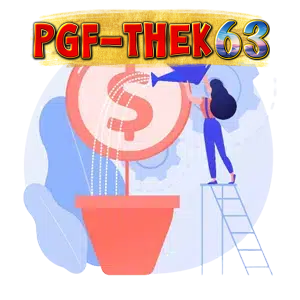
การกำหนดเป้าหมาย เงินทุน หรือกำไรให้ชัดเจนก่อนเดิมพัน
สำหรับเทคนิคนี้ สามารถนำไปใช้ได้ทุกการเดิมพัน พนัน เพียงแค่ผู้เล่นนั้นกำหนดเงินทุนเดิมพันและกำไรให้ชัดเจน หากคุณเล่นได้ รับกำไร ตามที่คุณตั้งเป้าหมายไว้ให้หยุดเดิมพันทันที

การวางเดิมพันแบบคงที่
สำหรับการวาง เดิมพัน แบบคงที่นั้น เหมาะสำหรับนักเดิมพันที่มีเงินทุนเดิมพันน้อย สามารถที่จะทำให้ผู้เล่นอยู่บนเกมได้ในเวลาที่ยาวนานมากยิ่งขึ้น และเป็นที่รู้กันดียิ่งหากเราอยู่บนเกมนานเท่าไหร่ ยิ่งจะทำให้เรามีโอกาสเข้าถึง เงินรางวัล ได้อย่างรวดเร็วอีกด้วย เพราะมีทั้งเงินรางวัล โบนัส และ แจ็คพอต รวมไปถึงการเข้าวินต่างๆ

การวางเดิมพันแบบทบทุน
การวาง เดิมพัน แบบทบทุนนั้น จะเป็นการเพิ่มรางวัลให้ผู้เล่นได้รับสูงขึ้นกว่าปกติ สำหรับใครที่มีเงินทุนปานกลาง สามารถใช้เทคนิคนี้ได้ หากคุณเดิมพันมีการ แตกรางวัล ให้คุณทบกำไรสูงขึ้นหนึ่งเท่าหรือสองเท่า เพราะเป็นที่รู้กันดีว่า เกมสล็อต นั้นจะจ่ายรางวัลจากการคูณเงินทุนเดิมพัน ดังนั้นยิ่งหากเราวางเดิมพันสูงเท่าไหร่ เราก็จะได้รับรางวัลมากเท่านั้น
แตกหนัก จ่ายเต็ม เว็บตรง pgf-thek63 ไม่ล็อคยุทธ ฝากง่าย ถอนไว ผ่าน Wallet ไม่ติดเทิร์น
ปั่นสล็อตผ่านเว็บไซต์เรา thek63 ไม่ว่าคุณจะแตกรางวัลเท่าไหร่ ก็สามารถที่จะกำหนดยอดถอนผ่านหน้าเว็บไซต์ได้เลยทันที ไม่มีขั้นต่ำ และที่สำคัญเว็บไซต์ของเรานั้น สามารถที่จะทำรายการต่างๆได้ด้วยระบบอัตโนมัติ และยังมาพร้อมกับการรองรับช่องทางการฝากถอนเงินได้มากกว่าหนึ่งช่องทาง ไม่ว่าจะเป็นผ่านแอพธนาคารที่รองรับกับทุกธนาคารชั้นนำของไทย
ยังรวมไปถึงการทำรายการผ่าน Wallet หรือแม้แต่เคาน์เตอร์เซอร์วิสหรือตู้เติมเงิน เว็บไซต์ของเรา Thek63 slot ก็สามารถที่จะรองรับการใช้งานได้เป็นอย่างดี จัดได้ว่าเดิมพันกับเราที่นี่ pgf-thek63 แตกรางวัลเท่าไหร่ สามารถถอนได้เลยทันทีตลอด 24 ชั่วโมง รองรับออโต้ ทุกช่องทางอัพยอดไว ไม่เกิน 3 วินาที การันตีไม่ติดเทิร์นขั้นต่ำ
FAQs คำถามที่พบบ่อย
สมัครเว็บตรง ต้องดาวน์โหลดแอพพลิเคชั่นหรือไม่
เว็บไซต์สล็อตออนไลน์ เว็บตรง ผู้เล่นไม่ต้องดาวน์โหลดแอพ ไม่ต้องติดตั้ง เพราะสามารถสมัครสมาชิกผ่านหน้าเว็บไซต์ หรือเป็นผ่านลิ้งค์แนะนำได้เลยทันทีตลอด 24 ชั่วโมง
จุดสังเกตสล็อตเว็บตรง มีลักษณะอย่างไร
สำหรับจุดเด่นสล็อตเว็บตรง จะมีช่องทางการเข้าเล่นที่มั่นคงและปลอดภัย มีใบเซอร์รับรองและเปิดให้บริการตลอด 24 ชั่วโมง ทุกฟังก์ชันเน้นย้ำการใช้งานด้วยระบบอัตโนมัติ มีทีมงานแอดมินคอยให้บริการตลอดเวลา
เดิมพันพนันออนไลน์ ฝากถอนเงินผ่านช่องทางใดปลอดภัยที่สุด
เพียงแค่คุณเลือกเดิมพันผ่านเว็บไซต์ตรง ไม่ว่าคุณจะเลือกช่องทางฝากถอนใด ล้วนแล้วแต่มีความมั่นคงและปลอดภัย ไม่ว่าจะเป็นการฝากถอนผ่านแอพธนาคารหรือจะเป็นการฝากถอนผ่าน Wallet รวมไปถึงเคาน์เตอร์เซอร์วิสหรือตู้เติมเงิน ก็สามารถที่จะทำรายการได้มั่นคง ปลอดภัย 100%
สรุป ช่องทางเดิมพัน ปั่นสล็อตเว็บตรง pgf-thek63 แจกเครดิตฟรี ฝาก-ถอนที่นี่ รองรับ Wallet
สำหรับช่องทางนี้ thek63 เป็นช่องทางที่ดีที่สุด ในการเดิมพันเล่นเกมพนันออนไลน์ ไม่ว่าจะชอบเกมที่มาในรูปแบบใด สามารถตอบโจทย์ตอบสนองกับความต้องการของนักเดิมพันได้เป็นอย่างดี อีกทั้งที่นี่ยังมาพร้อมกับการแจกโปรโมชั่นสุดร้อนแรง แจกเครดิตฟรีให้สมาชิกใหม่ได้รับสูงสุด 100% เพียงแค่คุณเข้าเล่นรับความคุ้มค่าได้เลยทันที และไม่ว่าคุณจะแตกรางวัลเท่าไหร่ที่นี่ Thek63 slot ยังมาพร้อมกับช่องทางการฝากถอนเงินที่มีความหลากหลาย สามารถเลือกใช้งานได้เลย ไม่ว่าจะเป็นผ่านแอพธนาคารหรือจะเป็นผ่าน Wallet
และยังมีเคาน์เตอร์เซอร์วิสและตู้เติมเงิน ให้คุณได้เลือกใช้งานตามความชื่นชอบหรือสะดวกและทุกช่องทางที่เราคัดสรรมานั้น ล้วนแล้วแต่รองรับการใช้งานที่เป็นระบบอัตโนมัติ และสามารถทำรายการได้แบบไม่มีขั้นต่ำ อัพยอดไวไม่เกินสามวิ ดังนั้นจึงกล้าการันตีเลยว่า เว็บไซต์ pgf-thek63 นี้ถูกพัฒนามาเพื่อการเดิมพันเล่นเกมสล็อตออนไลน์โดยเฉพาะ ดังนั้นจึงมีผู้เล่นทั้งหลายยกให้เป็นเว็บไซต์อันดับหนึ่งแห่งปี 2024

